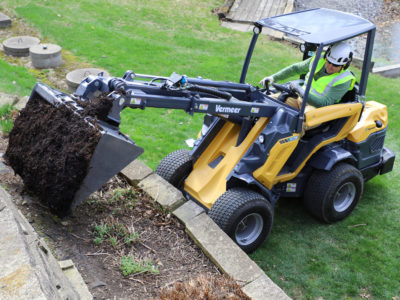A telescopic boom and an attachment plate make the Vermeer compact articulated loader (ATX) a versatile work tool capable of diverse jobs such as snow removal, tree care work, landscaping projects and more. The telescoping boom enables tasks to be completed quickly with minimal maneuvering while providing access to areas comparable machines can’t reach.
To take full advantage of Vermeer compact articulated loader performance, you need to understand the maximum load that can be handled under all the different operating conditions. “Often operators underestimate the actual weight of the object being lifted,” Vermeer tree care, rental and landscape product specialist, Kyle Newendorp, explained. “This weight should include the attachment, pallet, any rigging and the object itself. Don’t guess or make assumptions when calculating the total load to be lifted.”
Understanding the load chart
As a compact articulated loader turns, it articulates at the machine’s center pivot. This changes the machine’s center of gravity and has a direct impact on the weight the machine can handle. The maximum load capacity with a compact articulated loader occurs when the wheels are all in alignment. As you turn the steering wheel, and the articulation angle of the compact articulated loader increases, the rated operating capacity decreases until you reach the maximum articulation angle, where the machine is turned left or right as far as possible.
“Telescoping booms allow the operator to more efficiently pick up and place loads, but the operator needs to realize that the maximum load that can be moved decreases as the boom extends out farther from the compact articulated loader,” said Newendorp. “To illustrate this point, consider lifting a 1,000-lb (453.6-kg) load at 3 ft (.9 m). This load would exert a force of 1,000 lbs (453.6 kg) x 3 ft (.9 m), equaling 3,000 ft-lbs (4,067.5 Nm). If that same 1,000-lb weight was being lifted at 5 ft (1.5 m), it would exert a force of 5,000 ft-lbs (6,779.1 Nm). The machine sees more force as the boom extends.”
The load chart allows you to assess the maximum load in every situation, whether the loader is articulated or the boom is extended. These load charts define a working envelope that keeps the machine within appropriate limits as a machine articulates, lifts and extends a load outward. Review the load diagram in the operator’s manual prior to operation and apply the correct criteria. If the wheels are articulated, use the limits listed for the articulated load diagram in the operator’s manual.
The distances of the load from the center of the front axle and height of the load from ground level are indicated on the load chart for Vermeer compact articulated loaders. Calculate the distance you plan to extend the load and the height you plan to lift the load. Never exceed the weight limits within the defined working range.
Rated operating capacity for defined limits
The listed rated operating capacity is the maximum load you can carry with a compact articulated loader. It should be considered a hard rule to never exceed the rated operating capacity. It is calculated using the tipping load of the machine. The rated operating capacity of the compact articulated loader on firm and level ground when equipped with the fork attachment is calculated at 80% of the tipping load (per standard EN 474-3:2006+A1:2009). According to the same standard, on rough terrain, the rated operating capacity is 60% of the tipping load. Multiply the tipping load by .6.
For a compact articulated loader with a bucket attachment, the rated operating capacity in all ground conditions is calculated as 50% of the tipping load. Multiply the tipping load by .5 (per standard ISO 14397-1:2007).
The Vermeer ATX720 and ATX850 compact articulated loaders come with an optional 400-lb (181.4-kg) counterweight that bolts to the rear bumper which can allow you to maximize the load capacity on your compact articulated loader.
“The load chart typically includes the rated operating capacity at straight tipping load, full-turn tipping load, with and without counterweight, and at the full range of boom extensions,” said Newendorp. “Once the load on the front of the machine has been determined, the operator can refer to the load chart to make sure the task being performed will remain within the defined working envelope.”
The operator chooses the proper configuration for the ATX being operated and then compares the height of the load and distance from the front of the machine to the appropriate load chart. The load should never exceed what’s listed on the load chart. If ever in doubt on how to properly read the load chart, consult your local Vermeer dealer.
MultiOne SRL Corporation reserves the right to make changes in product engineering, design and specifications; add improvements; or discontinue manufacturing or distribution at any time without notice or obligation. Equipment shown is for illustrative purposes only and may display optional accessories or components specific to their global region. Please contact your local Vermeer dealer for more information on machine specifications.
Vermeer and the Vermeer logo are trademarks of Vermeer Manufacturing Company in the U.S. and/or other countries. © 2022 Vermeer Corporation. All Rights Reserved.
